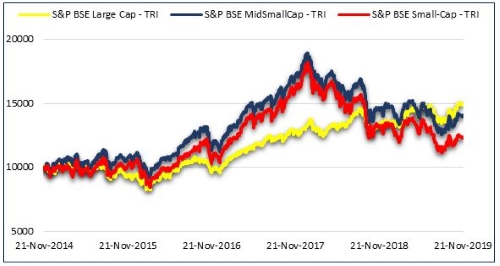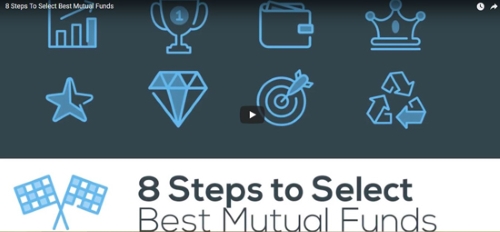 (Image source: pexels.com)
(Image source: pexels.com)
In an endeavour to accumulate wealth faster, you skew your portfolio heavily to small-cap funds. However, in the recent market rally, the small caps funds are still recuperating ever since the fall at the beginning of 2018. Among various market capitalisation baskets, the small-cap universe was the most adversely affected fraternity.
The investors are disappointed after betting on small-cap stocks and small-cap mutual funds since 2018 as most of them are still staring at double-digit losses. Their hope rally regarding small caps since the beginning of 2019 is yet to take-off.
Graph 1: Small caps and mid-caps sharply toppled down, and large caps showing signs of revival

Data as on November 23, 2019
(Source: ACE MF)
Frankly, this year began with multiple factors that drove the markets. Country's political uncertainty left the markets jittery, followed by Ms Nirmala Sitharaman's maiden Budget 2019 speech, the poignant news of poor consumerism, economic slowdown and the global geopolitical headwinds
Only after successive rate cuts by the RBI in its monetary policy review meetings and the slew of measures announced to improve the sluggish growth of the economy, markets have begun its upward rally (see above graph), but there is no respite for the small caps. That being said, one cannot rule out the possibility of heightened volatility given the headwinds in play.
[Read: Does It Make Sense To Continue SIP-Ping Into A Small-Cap Fund Now?]
Small caps are categorized as those stocks of companies that are beyond the first 250 companies on the basis of market capitalisation, as per the capital market regulator (SEBI).
However, a noteworthy trait about small-cap companies is usually due to their low trading volume, the investment risk associated with them is higher than with larger firms.
The inherent risk involved is due to their limited scale of operations, product lines, narrow distribution channels, limited financial and managerial resources, and greater sensitivity to dynamic economic conditions or any policy changes from the government of greater magnitude can have an undesirable impact on the business of small-cap companies, and in turn on their bottom-line.
On the other hand, generally smaller than their mid-cap counterparts and in the initial development phase, small-cap companies have the potential to grow multi-fold to become a formidable business entity or when the overall economy is witnessing accelerated growth. Their revenue and profit growth tend to outpace that of large-cap companies by a significant margin.
So, small caps have the tendency to go from electrifying highs to dangerous lows.
A small-cap mutual fund scheme, as defined by the capital market regulator, is required to invest a minimum of 65% of its total assets in equity & equity related instruments of small-cap companies.
While this might give you a feeling that the basket of small-cap stocks is fairly big, the reality is that many companies do not meet typical selection criteria of institutional investors like mutual funds.
And because of the risks associated with such stocks, buyers often exit when markets fall relentlessly. In such a situation, the fund manager may end up holding an illiquid stock or may sell it at a deep discount. And at the end of it, your investment in the fund would bear the brunt.
That's why small-cap funds are classified as 'high-risk-high-return' investment propositions.
Graph 2: Risk-returns placement of small caps

(Source: PersonalFN Research)
[Read: Why Comparing Returns to Risk Is More Meaningful!]
Similarly, if a small-cap fund holds a concentrated portfolio, it may experience higher volatility. Moreover, small-cap funds that churn their portfolio quite aggressively--following momentum--may not necessarily be the best performer. Once the momentum in a small-cap stock is lost, and/or at worst, if the valuations are high, small-cap funds may take years to reclaim their peaks.
Table: How small-cap funds fared?
| Scheme Name |
Absolute returns (%) |
CAGR (%) |
| 6 Months |
9 Months |
1 Year |
2 Years |
3 Years |
4 Years |
5 Years |
6 Years |
7 Years |
| SBI Small Cap Fund |
6.66 |
12.54 |
9.07 |
-2.86 |
15.58 |
13.35 |
15.98 |
27.17 |
23.93 |
| Nippon India Small Cap Fund |
-3.02 |
4.28 |
-3.27 |
-6.52 |
11.07 |
9.12 |
10.44 |
23.45 |
20.17 |
| HDFC Small Cap Fund |
-9.88 |
-5.23 |
-8.98 |
-5.79 |
10.33 |
9.51 |
8.83 |
15.64 |
14.33 |
| Kotak Small Cap Fund |
2.63 |
9.81 |
5.18 |
-5.11 |
6.99 |
7.67 |
8.10 |
17.91 |
14.37 |
| DSP Small Cap Fund |
-5.03 |
3.80 |
-2.43 |
-10.75 |
2.60 |
5.37 |
8.04 |
21.30 |
17.20 |
| Franklin India Smaller Cos Fund |
-7.72 |
-1.24 |
-5.08 |
-9.74 |
3.88 |
5.61 |
6.90 |
18.25 |
17.50 |
| Aditya Birla SL Small Cap Fund |
-11.26 |
-3.32 |
-9.74 |
-15.67 |
2.03 |
4.85 |
6.46 |
15.62 |
13.61 |
| ICICI Pru Smallcap Fund |
0.36 |
15.19 |
8.36 |
-7.48 |
6.23 |
5.63 |
5.28 |
11.87 |
11.71 |
| Category Average returns |
-2.54 |
3.83 |
-1.11 |
-8.22 |
6.23 |
6.35 |
7.41 |
16.97 |
14.59 |
| Nifty Smallcap 250 - TRI |
-8.84 |
-1.18 |
-6.51 |
-15.46 |
3.31 |
2.99 |
3.60 |
14.57 |
10.84 |
| S&P BSE SENSEX - TRI |
4.02 |
13.70 |
16.70 |
10.96 |
17.26 |
13.17 |
8.74 |
13.73 |
13.32 |
| S&P BSE Small-Cap - TRI |
-6.24 |
-0.28 |
-5.97 |
-12.72 |
5.62 |
5.00 |
4.25 |
15.33 |
10.71 |
The returns generated are point to point returns, for upto one-year absolute returns are considered and from two year onwards CAGR.
Data as on November 25, 2019
(Source: ACE MF)
*Please note, this table only represents the best performing Small-Cap Funds based solely on past returns and is NOT a recommendation. Mutual Fund investments are subject to market risks. Read all scheme related documents carefully. Past performance is not an indicator for future returns. Speak to your investment advisor for further assistance before investing.
Those who expected this segment to rev the pace of wealth creation like a Ferrari have been let down.If you have any small-cap fund in your portfolio that's underperformed constantly, it's perhaps time to review your mutual fund portfolio.
But at the same time, a handful have managed to create wealth in the long run as seen from the table above. Beyond 3-year time frame, some small-cap funds have well outperformed S&P BSE Small Cap-TRI and Nifty Smallcap 250 - TRI, while some of the schemes have even outperformed S&P BSE SENSEX - TRI beyond 5-year time period.
The trailing P/E of the S&P BSE SmallCap Index is around 32.4x. It has plummeted from its earlier highs, but that doesn't mean valuation-wise small-caps are cheap or even reasonable.
The fact is, many constituents of the BSE SmallCap index are making losses. Only a handful of small-cap companies can manage financial stress, and those who pile up massive debt are rarely able to manage it when the going gets tough.
[Read: Market P/E Ratio Driving Your Mutual Fund Decisions? Big Mistake!]
If you hold a well-managed small-cap fund/s, based on its qualitative and quantitative parameters which point out the performance across various market cycles and phases. The parameters also indicate to the fund houses that have robust systems and processes in place to deal with any market shocks and undercurrents.
And if you as an investor that are diligently investing via Systematic Investment Plan (SIP) to mitigate the risk due to the rupee-cost averaging feature, with an investment time horizon of more than five years, small-cap funds can generate stupendous returns.
Watch this video on how to select best mutual fund schemes for your portfolio:

Editor's note:
The markets have corrected significantly to offer a decent margin of safety and opportunity for long term investors. We have identified five high alpha generating funds selected through PersonalFN's special 'SMART Alpha' methodology
This model helps us zero in on quality names that have the ability to trump the benchmark and generate alpha returns for its long-term investors.

Click here to get access to our latest exclusive - The Alpha Funds Report - 2019.
Add Comments